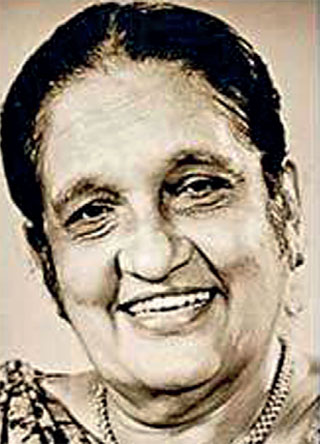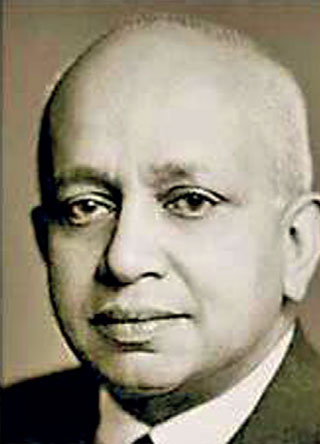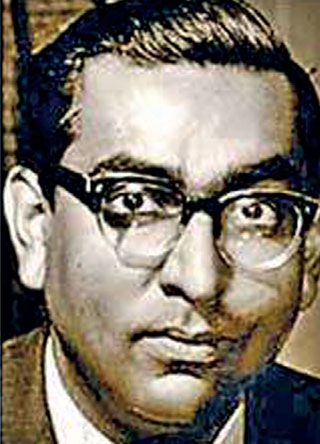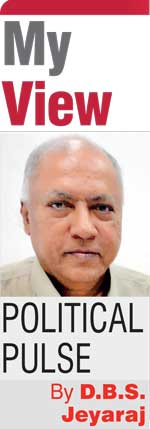Thursday Apr 24, 2025
Thursday Apr 24, 2025
Wednesday, 1 February 2023 00:30 - - {{hitsCtrl.values.hits}}

Sirimavo Bandaranaike

Sir Oliver Goonetilleke

Felix R. Dias Bandaranaike
|

Sri Lanka formerly known as Ceylon is about to celebrate its 75th anniversary of independence from Britain on 4 February. The island nation has in its 75-year post-independence period experienced several troubles and upheavals ranging from communal pogroms to internal civil wars. In spite of these trials and tribulations, Sri Lanka can be proud of continuing to remain a democracy. A democracy with many flaws but nevertheless a democracy!
One of the many crises undergone by the island nation in its earlier Ceylon avatar was the 1962 Coup d’etat conspiracy. Coup d’etat meaning “stroke of state” in French is used to describe the overthrow or deposition of a government or head of state through illegal or unconstitutional means. A coup d’etat generally referred to as a coup is usually undertaken by officer/s of armed forces against the established government.
Sri Lanka known as Ceylon had its first taste of a military coup in January 1962 when a group of Army, Navy and Police officers together with a senior civil servant devised a blueprint to overthrow the democratically elected Sri Lanka Freedom Party (SLFP) government of the then Prime Minister Sirimavo Bandaranaike. The plan was to take over the capital Colombo and seize state power through a series of coordinated military operations in one night. The objective was to overthrow the Government on the night of 27 January 1962.
However the envisaged coup never got off the ground because it never got beyond the conspiracy stage to that of execution. The ringleaders called it off on the 27th evening because there was a “leak” and they feared the coup was compromised. Despite the coup not being enacted, there was an official crackdown. Several persons, most of them defence service personnel were arrested, detained, interrogated and subsequently charged in courts. Nevertheless the fact remains that the abortive coup of 1962 was essentially a conspiracy as there was no related action except for the arrest of a left-party MP in the Southern Province.
The attempted coup of 1962 and its aftermath have aroused my passionate interest since boyhood. I have written about many aspects of the coup in the past. However I am frequently amazed by the interest and curiosity of readers from different age groups and ethnicity in the abortive coup. The 61st anniversary of the 1962 coup attempt fell last week on 27 January. I have been receiving several requests from readers to write about it. I intend therefore to re-visit the 1962 coup in these columns with the aid of some of my earlier writings.
Three noteworthy aspects
The 1962 coup d’etat conspiracy had three noteworthy aspects. Firstly the architects of the conspiracy wanted a bloodless coup. The planning of the coup was done with the objective of avoiding bloodshed. Important people were to be either detained or have their movement restricted for specific periods of time but would not have suffered summary execution. It was this desire to avert bloodshed that caused the chief conspirators to abort the mission when it was compromised.
Secondly the execution of the coup entailed a quick seizure of power and takeover of Government. The task was to be completed within a few hours. This was to avoid a protracted struggle for power that could possibly have resulted in huge losses of life, limb and property. Also presenting a speedy “fait accompli” would have been a deterrent to potential international intervention on behalf of the incumbent regime. Thirdly the coup conspirators had no intention of retaining power and control permanently. After dissolving Parliament and consolidating power under military rule, they envisaged a temporary governance of the country under a regency council presided over by the Governor- General. Thereafter, a new, progressive constitution was to be promulgated and fresh elections held. As to whether these intentions would have been upheld, if and when the coup was executed, is indeed a pertinent question. However, no specific answer is available because the coup d’etat planners had called it off beforehand.
Six coup architects
Six persons could be described as the architects who designed the coup. They were:
1. Don John Francis Douglas Liyanage, CCS – Deputy Director of Land Development.
2. Colonel F.C. de Saram, OBE – Deputy Commandant, Volunteer Force.
3. Colonel Maurice De Mel – Commandant, Ceylon Volunteer Force and former Chief of Staff of the Army.
4. Cyril Cyrus, “Jungle” Dissanayake – Deputy Inspector General of Police (DIG).
5. Sidney Godfrey de Zoysa – Retd. Deputy Inspector General of Police (DIG).
6. Rear Admiral Gerard Royce Maxwell de Mel, OBE. Royce de Mel had recently been relieved as navy Commander then designated as Captain of the Navy over a controversy regarding smuggled goods being discovered in a naval vessel.
However the only civilian in this six, Douglas Liyanage, though very much involved in formulating the coup project was not involved in its planning and execution. The coup codenamed ‘Operation Holdfast’ was devised by the five defence officials who could be termed ring leaders. It was F.C. de Saram known as Derek who was the moving spirit of the coup. De Saram was the chief strategist who conceptualised and mapped out the entire exercise while Sidney de Zoysa was the premier tactician who planned out the operational manoeuvres and nitty-gritty facets of ‘Operation Holdfast’.
Codename ‘Operation Holdfast’
The choice of the codename ‘Operation Holdfast’ is rather intriguing. It was the practice in the last century for codenames to be used for regiments/corps in radio communications of the British armed forces as well as those of countries in the Empire/Commonwealth. Some examples are Foxhound-Infantry, Sheldrake-Artillery, Ironside-Armour, Pronto-Signals, Acorn-Intelligence and Starlight-Medical. In that context ‘Holdfast’ referred to the Engineering Corps.
I do not know whether it was the Engineers Corps references to Holdfast that influenced the Coup codename of ‘Holdfast’. However upon reflection it does seem an appropriate term for the coup. ‘Holdfast’ could mean establishing a key position and then staying put. An entrenched position that must be ‘held fast’ at any cost. Seizing power and retaining control was the essence of the coup d’etat. The codename ‘Holdfast’ therefore sums it up perfectly.
Troops and officers from the 3rd Field Artillery Regiment, 2nd Volunteer Anti-aircraft Regiment of the Ceylon Artillery, 2nd (V) Field/Plant Regiment, Ceylon Engineers, 2nd Volunteer Signals Regiment, Ceylon Signals corps, the Reconnissance Regiment and the Sabre troop of the Ceylon Armoured Corps were to be utilised for the ‘Operation Holdfast’ from the army.
Associated with the military would be selected Police officers and policemen mainly from Colombo and suburban areas. Subsequently after the coup was effected, personnel from the Navy and Air Force were also expected to assist the newly set up military administration. No officers of the Navy or Air Force were involved in the planning of the coup except the former Navy chief Rear Admiral Royce de Mel.
‘Take Post’ order
The blueprint for the coup codenamed “Operation Holdfast” was roughly this. At 10 p.m. on 27 January senior DIG Police “Jungle” Dissanayake was to issue a “Take Post” order to his men. A take post order means establishing or occupying an offensive or defensive position.
Immediately after the order ASP Bede Johnpillai who was in charge of traffic would clear all main roads and strategically important highways of traffic. This was to be accomplished in 30 minutes. The clearing of traffic in roads was to facilitate the smooth, swift, unhindered progress of military convoys and columns along roads towards their target destinations. This deployment was under the personal supervision of Col. F.C. de Saram and Col. Maurice de Mel. It was to begin at 11 p.m. on Saturday (27) and cease by 3 a.m. on Sunday (28).
DIG “Jungle” Dissanayake was to commence his part of the “coup” operations from 11 p.m. on 27 January. The Police headquarters and Criminal Investigations Department (CID) offices in Fort were to be taken over at midnight. CC “Jungle” Dissanayake was to be at “Queen’s House” (President’s House) in Fort and direct operations from there until Police/CID headquarters was taken over.
“Queen’s House”
Queen’s House was the official residence of then Governor-General Sir Oliver Goonetilleke who was later implicated in the abortive coup. Once “Jungle” moved into Police Headquarters in Fort and took charge, retired Police DIG Sidney de Zoysa was to join him.
The password for operations at Queens House and the Police Headquarters was to be “Dowbiggin”. This was the name of a former IGP. Sir Herbert Layard Dowbiggin served as IGP in Ceylon/Sri Lanka from 1913 to 1937. Interestingly, both CC Dissanayake and Sidney de Zoysa joined the Police Force as Assistant Superintendents of Police when Dowbiggin was IGP. Dowbiggin interviewed and selected them personally.
Cordoning off Colombo
A crucial part of “Operation Holdfast” was the seizing of Colombo city and cordoning it off. This was deemed to be of vital importance as a potential counter-strike by officers and troops loyal to the government was feared. It was necessary therefore to prevent soldiers from the first battalion of the Ceylon Light Infantry stationed at the Panagoda cantonment entering Colombo until the transfer of power was completed. Also it was necessary to seal off Colombo to prevent certain individuals and groups from exiting or entering the capital for a specific period.
Army personnel with armoured cars were to be stationed at the two Kelani River bridges, the Wellawatte-Dehiwela Bridge and the Kirulapone Bridge. In addition military personnel with radio equipment would be stationed at key locations in suburban Colombo. Soldiers with vehicles were to be positioned in strategic junctions within Colombo city also. It is learnt that some armoured cars had been stationed at Kirulapone before the coup was called off.
At midnight Police cars equipped with radio and loudspeakers were to go around Colombo and outskirts announcing a 24-hour curfew. People were to be warned to remain indoors and that anyone seen outside would be shot on sight. As a precautionary measure, many Police vehicles at the Thimbirigasyaya Police depot were rendered immobile by siphoning off the petrol in the vehicle tanks.
Key installations take-over
While curfew announcements were being made, key installations were to be taken over in a rapid “blitzkrieg” like manoeuvre. The old Parliament (now Presidential Secretariat) the Old Secretariat building, Fort and Maradana Railway Stations, Pettah Bus Terminal, the Light House, Harbour, etc. were to be occupied by pro-coup troops. The Central Telephone and Telegraph exchanges would be taken over and all tele-communication suspended until further notice. The newspaper offices of Lake House and Times of Ceylon were also to be taken over and newspapers were to cease publication for a few days.
There was no television in Sri Lanka in those days and the most important communications institution was “Radio Ceylon”. Fully armed Signals corps despatch riders on motorcycles were to be positioned from 11 p.m. on 27 January at Torrington (Independence) Square. At H-hour when the password “Holdfast” is given these troopers were to storm “Radio Ceylon” and take it over. Thereafter the country was to be informed by radio of the takeover of Government through the coup. In anticipation of the coup the conspirators in the Army sappers had on Thursday 25 January laid out a special telephone line from the Army headquarters at Lower Lake Road to the Army barracks in Echelon Square in Fort. This secure line was to be used for urgent intra-army communication. “Col” Maurice de Mel was to be at Army headquarters coordinating matters while F.C. de Saram was to be at “Temple Trees”. “Jungle” Dissanayake would operate from Police headquarters/Queens House.
Sirimavo Bandaranaike
According to “Operation Holdfast” plans, the Prime Minister Sirimavo Bandaranaike was to be taken into custody. Originally the PM was scheduled to participate in some religious observances at Kataragama on Saturday 27 January. She was to depart from Colombo on Friday 26 January and return on Sunday 28 January evening.
DIG (Retd.) Sidney de Zoysa went down to the South on 25 January and devised a plot to have the PM arrested in the Hambantota district. ASP David Thambyah was to apprehend her at Hungama. She was to be escorted safely back to Colombo and placed under house arrest at the Rosemead Place residence “Tintagel”.
However things changed when Sirimavo suddenly cancelled her Kataragama trip. This was because the Prime Minister’s secretary Bradman Weerakoon reminded Bandaranaike that she had earlier turned down an invitation to attend a religious ceremony at the Getambe Vihara in Kandy due to some important work in Colombo. Hence the Getambe prelate may take offence at her declining his invitation and going to Kataragama instead, pointed out the PM’s secretary. The premier therefore cancelled her K’gama trip.
Temple Trees
When this cancellation became known there was a hasty change of plan. While ASP Thambyah was to remain alert in case the PM revised her itinerary again, it was decided to arrest her on Saturday night within the precincts of the PM’s official residence “Temple Trees”. The senior Police officer in charge of security at Temple Trees was Asst. Supt of Police W.T. Dickman. However he was replaced at short notice by ASP Stanley Jirasinghe on the orders of DIG Dissanayake. ASP Jirasinghe was the DIG’s PA and extremely loyal to “Jungle” Dissanayke.
Lt. Col. Wilmot (Willie) Abraham MBE the commanding officer of the 3rd field artillery regiment was to take over Temple Trees with some soldiers. Stanley Jirasinghe’s task was to assist Willie Abraham in the takeover of Temple Trees. Col. F.C. de Saram was to position himself at the Prime Minister’s official residence Temple Trees at the earliest and direct operations from there. The password there was to be “British Grenadier”. This was the title of the Artillery regiment’s marching tune.
Col. “Derek” de Saram was a close relative of S.W.R.D. Bandaranaike (SWRD and De Saram’s wife Nedra’s father Stanley Obeyesekere were first cousins). Col. de Saram would personally inform Bandaranaike of the coup and take into custody the premier. Thereafter Bandaranaike was to be placed under house arrest at Tintagel with her children Sunethra (18), Chandrika (16) and Anura (12). She would be given the choice of acknowledging the coup and joining the Governing council to be set up for an interim administration. If she declined Bandaranaike and her three children were to be relocated to Britain with a generous monthly pension in sterling currency. There was absolutely no question of bodily harm being done to her or the children.
“Dangerous Dias duo”
Prime Minister Sirimavo Bandaranaike’s cabinet in which she was in charge of defence and external affairs, comprised 11 ministers. The ministers were to be placed under house arrest with the exception of Finance Minister Felix R. Dias Bandaranaike who was also the Parliamentary Secretary of the Ministry of Defence and External Affairs. Junior Minister Felix Bandaranaike and the then powerful Defence and External Affairs Ministry Secretary Neil Quintus Dias were to be arrested and held at the Army headquarters on Lower Lake Road. FRD Bandaranaike and NQ Dias were regarded as the “dangerous Dias duo” responsible for much of the “Sinhala Buddhist” politicisation of the defence sector despite Felix being an Anglican Christian.
Several other important defence officials were also to be taken to Army headquarters and detained. These included the DIG-CID S.A. Dissanayake (Jingle) who was a brother of DIG CC Dissanayake (Jungle), acting Navy chief Rajan Kadirgamar and SP-CID John Attygalle .Those taken to Army headquarters were to be detained in underground bunkers used to store ammunition at the armoury. They were to be held incommunicado for a certain period.
Col. Maurice de Mel, the commandant of the Ceylon Volunteer Force and former Chief of Staff of the Army was to station himself at the Army headquarters and direct his side of the coup operations from there. The officer in charge of the Guard room at Army H’quarters on 27/28 night was to be Capt. Robert Poulier, one of those involved in the coup conspiracy. He later shot himself after being interrogated. The password to be used at the Army H’quarters was “Yathura” (key).
Other cabinet ministers, and important officials were to be placed under virtual house arrest. These included the IGP Abeykoon, Air Force chief Barker and Army Commander Wijekoon. Their movement was to be restricted to their homes alone. However the acting Navy chief Rajan Kadirgamar was to be detained at the army headquarters.
MPs to be detained at “Sravasti”
In another facet of Operation Holdfast, a large number of Government members of Parliament and leftist MPs of the opposition were to be detained en masse at the “Sravasti” MP’s hostel. These included all LSSP, MEP and CP members. Some party leaders were to be placed under house arrest in their own homes in Colombo. Ministers, MPs, trade unionists and journalists perceived as “threats” were to be incarcerated. Among these were CMU Gen. Secy Bala Tampoe, CTUF Gen-Secy Nagalingam Shanmugadasan and “Tribune” Editor S.P. Amarasingham.
Sir Oliver Goonetilleke
Once the coup was accomplished the ring leaders were to converge at “Queens House” and request: Governor-General Sir Oliver Goonetilleke to dissolve Parliament and take direct authority. The coup conspirators did not seem to have plans of retaining power for themselves after acquiring it. At least that is what it seemed at that time.
(The writer can be reached at [email protected].)
Discover Kapruka, the leading online shopping platform in Sri Lanka, where you can conveniently send Gifts and Flowers to your loved ones for any event including Valentine ’s Day. Explore a wide range of popular Shopping Categories on Kapruka, including Toys, Groceries, Electronics, Birthday Cakes, Fruits, Chocolates, Flower Bouquets, Clothing, Watches, Lingerie, Gift Sets and Jewellery. Also if you’re interested in selling with Kapruka, Partner Central by Kapruka is the best solution to start with. Moreover, through Kapruka Global Shop, you can also enjoy the convenience of purchasing products from renowned platforms like Amazon and eBay and have them delivered to Sri Lanka.
Discover Kapruka, the leading online shopping platform in Sri Lanka, where you can conveniently send Gifts and Flowers to your loved ones for any event including Valentine ’s Day. Explore a wide range of popular Shopping Categories on Kapruka, including Toys, Groceries, Electronics, Birthday Cakes, Fruits, Chocolates, Flower Bouquets, Clothing, Watches, Lingerie, Gift Sets and Jewellery. Also if you’re interested in selling with Kapruka, Partner Central by Kapruka is the best solution to start with. Moreover, through Kapruka Global Shop, you can also enjoy the convenience of purchasing products from renowned platforms like Amazon and eBay and have them delivered to Sri Lanka.